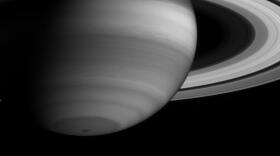-
Astronomers Bob Berman and Dr. Valerie Rapson join us to discuss recent space news and answer your questions. Ray Graf hosts.
-
Strange Universe With Bob BermanIf you're hearing this on Sunday, Saturn is at its closest point to Earth, and its rings appear as a straight white line due to their edge-on alignment — a rare event that occurs every 15 years during its equinox. Earth’s own equinox arrives Monday at 2:10 PM, marking the start of autumn in the Northern Hemisphere. This equinox often falls on the 22nd or 23rd because, as Kepler explained, Earth speeds up in its orbit when closer to the sun in January and slows down in July. That means winter is shorter than summer by about a week — a fact disguised by our calendar and the uneven placement of long and short months.
-
Strange Universe With Bob BermanSummer Solstice Oddities: On Friday, June 20th at 10:43 p.m. marks the official start of summer! While ancient cultures celebrated solstices with flair (sometimes literally tossing people off pyramids), we now settle for noting the longest day of the year. Expect the sun at its highest, shortest shadows, and sunsets as far north as they get. Upstate New York gets over 15 hours of sunlight and the longest twilight of the year—great for solar fans, not so much for stargazers.
-
Strange Universe With Bob BermanThis week look for the Moon—and just to its left, you'll spot a bright, orange-red star: Antares. While most reddish stars in the universe are small and dim (like Proxima Centauri, our nearest stellar neighbor), Antares stands out as a red supergiant—huge and luminous. In fact, it's in a long-running rivalry with Betelgeuse over which is the biggest red star in the sky. We’re not exactly sure which one wins, but we do know Antares has a great name—meaning “rival of Mars” for its Mars-like glow. So step outside, take a look, and decide for yourself.
-
Strange Universe With Bob BermanSo far this cold season, Earth's sister planet has heated up the evening sky like a UFO. You've surely seen that dazzling "star" soon after sunset: This has been its best showing since 2017. That eight-year interval is no accident. So happens, 13 of Venus’ years around the Sun have the same number of days as eight Earth years. They both work out to 2,922 days. Tune in to hear when you can see expect these special evenings.
-
Strange Universe With Bob BermanDo you want to understand climate change – really understand it – in under 3 minutes? Then pull up a chair. It all revolves around the trapping of heat, which is far simpler and more fascinating than people seem to believe.
-
Strange Universe With Bob BermanA lunation is the term for the Moon passing through all of its phases, which takes 29.5 days and was the basis for the calendar month. A lunation always begins with the New Moon, which will oddly happen the final days of the year, next week, guaranteeing unusual darkness for the upcoming New Year’s Eve. Tune in to hear some weird facts about the moon and the controversial statistics that indicate a bit more cloudy weather.
-
Strange Universe With Bob BermanIf someone you know has their head in the stars, here are some last minute gift ideas. Binoculars, which can provide mind-blowing images of the things like the Pleiades, star clusters, Andromeda Galaxy and the Milky Way.
-
Strange Universe With Bob BermanDo you or any of your friends know the most abundant element in your body is oxygen? Can you name the only major moon that does not circle around its planet’s equator? (That’s our own Moon). Have any idea that the average cloud weighs one million pounds? We’ll give credit to those who showed us the fundamentals.
-
Strange Universe With Bob BermanSaturn arrives at its closest point to Earth of the entire year. So let’s locate it. It’s the ONLY bright star in that entire section of the heavens. We’ll also discuss Saturn’s composition and its journey around the sun.

Play Live Radio
Next Up:
0:00
0:00
Available On Air Stations










